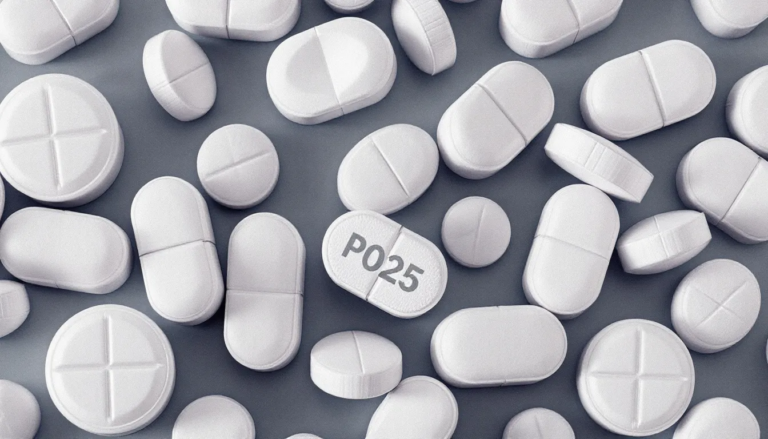
The M365 pill white is a pain reliever with acetaminophen and hydrocodone. It treats moderate to severe pain. This article explains its uses, side effects, and safety.
Key Takeaways
The M365 pill is a combination of acetaminophen and hydrocodone, primarily used for managing moderate to severe pain.
Strict adherence to dosage guidelines is essential to avoid serious side effects, including addiction, overdose, and liver damage.
Proper storage and disposal practices are crucial to prevent misuse and ensure safety, as the M365 pill is classified as a Schedule II controlled substance.
Table of Contents
Overview of the M365 Pill White
The M365 pill is classified as an opioid analgesic combination drug, primarily used to alleviate moderate to severe pain. Manufactured by Mallinckrodt Pharmaceuticals, this pill combines acetaminophen and hydrocodone to provide effective pain relief.
Physical Characteristics
The M365 pill is white and oval-shaped, with an imprint reading ‘M365’ on one side. Measuring approximately 15mm in width, its distinct physical characteristics make it easily identifiable.
Active Ingredients
Each M365 pill contains acetaminophen 325 mg and 5 mg of hydrocodone bitartrate, a combination that provides effective pain relief. Acetaminophen acts as a fever reducer and mild pain reliever, while acetaminophen hydrocodone bitartrate, a synthetic opioid, addresses more severe pain.
Medical Indications
The M365 pill is used to treat several medical issues. It is prescribed for moderate to severe pain, post-operative discomfort, and chronic pain conditions. It is often recommended when non-opioid options have been exhausted, making it a critical tool in pain management.
For elderly patients and those recovering from surgeries, the M365 pill offers significant relief, aiding in recovery and improving quality of life. The combination of hydrocodone and acetaminophen alters the body’s pain response, making it an effective choice for managing ongoing severe pain.
How the M365 Pill Works

The M365 pill’s effectiveness in pain relief stems from its two active ingredients: acetaminophen and hydrocodone. While acetaminophen primarily reduces fever and relieves mild to moderate pain, hydrocodone, a potent synthetic opioid, targets more severe pain by interacting with the brain’s pain regulation pathways.
Mechanism of Action
Hydrocodone functions by binding to opioid receptors in the central nervous system, helping to modulate pain perception. This binding action in the brain and spinal cord significantly alleviates pain, making it effective for moderate to severe pain management.
Acetaminophen, on the other hand, enhances hydrocodone’s pain-relieving effects by inhibiting prostaglandin production in the brain, thus providing a complementary mechanism of action. Together, these ingredients ensure a more comprehensive approach to pain relief.
Onset and Duration
Pain relief from the M365 pill typically begins within 30 to 60 minutes after ingestion, with effects lasting about 4 to 6 hours. This duration necessitates careful management of dosing intervals to maintain effective pain relief.
Dosage and Administration Guidelines
Administering the M365 pill requires strict adherence to dosage instructions to ensure safety and effectiveness. It’s essential to follow the prescribed dose and avoid alcohol and other CNS depressants during treatment.
Prescribed Dose
The typical dosage for pain relief from the M365 pill ranges from 2.5 mg acetaminophen 325 to 10 mg every 4 to 6 hours as needed, with a maximum of 8 tablets in 24 hours to prevent acetaminophen toxicity. Your healthcare provider may adjust your dosage based on your response to treatment and specific medical condition.
Special populations, including children and those with renal or hepatic impairments, require tailored dosages. Always inform your physician if the medication doesn’t provide sufficient pain relief for necessary adjustments.
Safe Use Practices
Inform your healthcare provider about your medical history, allergies, and any other medications you are taking before starting treatment with the M365 pill. Avoiding alcohol and other CNS depressants is crucial, as their combination with the M365 pill can increase the risk of overdose and severe side effects.
Take the M365 pill precisely as prescribed, never sharing it or increasing the dosage without consulting your healthcare provider. Be cautious, as the pill can interfere with motor skills and cause dizziness, affecting your physical or mental status.
Potential Side Effects and Risks

While the M365 pill provides significant pain relief, it also comes with potential side effects and risks.
Managing and monitoring these side effects are crucial for safe use.
Common Side Effects
Common side effects of the M365 pill include drowsiness, nausea, and constipation. Nausea and vomiting can result from acetaminophen, while dizziness can impair coordination and increase fall risk.
If severe side effects occur, seek medical attention immediately.
Severe Reactions
Serious side effects of the M365 pill include severe dizziness, shallow breathing, and mood changes. Severe reactions such as fainting, seizures, and respiratory depression require immediate medical attention.
Symptoms of hydrocodone toxicity include CNS depression, low blood pressure, low heart rate, and labored breathing. Misuse of the M365 pill, especially in combination with alcohol or other drugs, greatly increases the risk of opioid overdose, which can be fatal if untreated.
Long-Term Risks
Long-term use of the M365 pill can lead to tolerance, requiring higher doses for the same pain relief effect. This increased dosage can escalate the risk of addiction, especially if the medication is used beyond the prescribed amounts.
Excessive intake of acetaminophen can lead to hepatotoxicity, affecting liver function negatively. Both physical and psychological dependence are potential risks of prolonged use.
Recognizing and Managing Withdrawal Symptoms

Recognizing and managing withdrawal symptoms is crucial for anyone discontinuing the M365 pill. These symptoms can be both uncomfortable and potentially dangerous.
Withdrawal Symptoms
Common withdrawal symptoms include excessive sweating, muscle pain, and diarrhea. Anxiety and physical discomfort are also prevalent during hydrocodone withdrawal.
Recognizing these symptoms early can facilitate timely intervention.
Treatment Options
Treatment options for managing withdrawal symptoms from the M365 pill include addiction recovery programs and outpatient drug rehab. Cognitive-behavioral therapy is effective. Additionally, spiritual and emotional healing also shows positive results.
Medical detox using medications such as methadone and buprenorphine can reduce cravings and safely manage withdrawal symptoms. The safest approach to stopping the use of the M365 pill is to seek help from a professional drug rehab.
Addiction and Overdose Prevention

Preventing addiction and overdose is paramount when using narcotic pain relievers like the M365 pill. Understanding the signs and taking preventive measures can save lives.
Signs of Addiction
The M365 pill is highly addictive due to its hydrocodone content, leading to risks of opioid addiction. Common indicators of addiction include experiencing withdrawal symptoms or using the pill more than recommended. Long-term abuse can result in drowsiness, nausea, constipation, and potentially opioid use disorder.
Early recognition of addiction can facilitate effective treatment and intervention.
Overdose Symptoms
Overdose symptoms can manifest in various ways, particularly affecting breathing and skin appearance. Signs of an overdose may include difficult breathing and bluish skin or lips.
Seek emergency medical help immediately if an overdose is suspected.
Preventive Measures
Using the M365 pill longer than prescribed significantly raises the risk of addiction. The opioid epidemic has seen a staggering increase in overdose deaths, highlighting the need for preventive measures.
Following your healthcare provider’s guidelines, using community drug take-back programs, and staying informed about safe use can help prevent addiction and overdose.
Safe Storage and Disposal
Proper storage and disposal of the M365 pill prevent misuse and environmental contamination.
Storage Tips
Keep the medication out of reach of children and use a locked medicine cabinet when possible. Store the M365 pill in a cool, dry environment and ensure it is kept in its original container with the lid tightly closed.
Disposal Methods
Use drug take-back programs or medicine drop-off boxes for disposal. Safe disposal methods help prevent environmental contamination and reduce the risk of prescription drug abuse.
Improper disposal can lead to unintended access, contributing to substance abuse, misuse, and addiction.
Legal and Regulatory Information
The legal and regulatory aspects of the M365 pill are crucial for ensuring its safe use and preventing abuse.
Controlled Substance Classification
The M365 pill is classified as a Schedule II narcotic under the Controlled Substances Act due to its high potential for abuse and risk of dependence.
Drugs in Schedule II require special handling and strict regulatory oversight.
Prescription Regulations
A prescription medication is required to obtain the M365 pill, and a government-issued ID is needed at the pharmacy. Clinics impose restrictions on refills to reduce prescription medications abuse.
Summary
The M365 pill, a powerful combination of acetaminophen and hydrocodone, is a highly effective prescription medication for managing moderate to severe pain. Understanding its uses, mechanisms, and potential side effects is crucial for safe and effective pain management. From its physical characteristics and active ingredients to the detailed dosage guidelines and the importance of safe storage and disposal, each aspect is vital for ensuring responsible use.
By adhering to prescribed dosages, recognizing signs of addiction, and taking preventive measures, patients can mitigate risks associated with opioid medications. Remember, always consult with your healthcare provider for any concerns or adjustments needed during your treatment. Armed with this knowledge, you can navigate the complexities of pain management with greater confidence and care.
Frequently Asked Questions
What is the M365 pill used for?
The M365 pill is primarily prescribed to alleviate moderate to severe pain, particularly in cases such as post-operative recovery or chronic pain when other treatments are inadequate.
How does the M365 pill work?
The M365 pill effectively reduces pain by combining hydrocodone, which targets opioid receptors in the brain, and acetaminophen, which enhances pain relief by inhibiting prostaglandin production. This dual-action approach provides comprehensive pain management.
What are the common side effects of the M365 pill?
Common side effects of the M365 pill include drowsiness, nausea, constipation, and dizziness. It’s crucial to seek immediate medical attention for severe side effects such as respiratory depression and liver failure.
How should I store and dispose of the M365 pill?
Store the M365 pill in a cool, dry place away from children, ideally in a locked cabinet. For disposal, utilize drug take-back programs or drop-off boxes to prevent misuse and environmental harm.
What are the signs of addiction to the M365 pill?
Signs of addiction to the M365 pill include using it more than prescribed, experiencing withdrawal symptoms, and the onset of opioid use disorder. Early intervention with healthcare professionals is crucial for effective treatment.
Dr. Mitchell G. Cohen is a board-certified Internal Medicine specialist with over 34 years of experience in patient-centered healthcare. A graduate of Hahnemann University School of Medicine, Dr. Cohen completed his internship at the University Health Center of Pittsburgh, where he gained invaluable hands-on experience. He is also a certified addiction specialist, holding membership with the American Society of Addiction Medicine (ASAM).
Currently based in Nashua, NH, Dr. Cohen is affiliated with Saint Joseph Hospital, where he provides comprehensive care focusing on both internal medicine and addiction treatment. His expertise includes prevention, diagnosis, and management of adult diseases, as well as specialized care for individuals facing substance use disorders.
Dr. Cohen is committed to fostering open communication, ensuring his patients are fully informed and empowered to make confident decisions about their health and treatment options.

MD Mitchell Grant Cohen
Dr. Mitchell G. Cohen is a board-certified Internal Medicine specialist with over 34 years of experience in patient-centered healthcare. A graduate of Hahnemann University School of Medicine, Dr. Cohen completed his internship at the University Health Center of Pittsburgh, where he gained invaluable hands-on experience. He is also a certified addiction specialist, holding membership with the American Society of Addiction Medicine (ASAM).
Currently based in Nashua, NH, Dr. Cohen is affiliated with Saint Joseph Hospital, where he provides comprehensive care focusing on both internal medicine and addiction treatment. His expertise includes prevention, diagnosis, and management of adult diseases, as well as specialized care for individuals facing substance use disorders.
Dr. Cohen is committed to fostering open communication, ensuring his patients are fully informed and empowered to make confident decisions about their health and treatment options.







